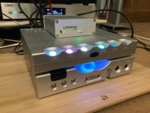Ed Selley
Active Member
It must be a day for SOtMs as mine has mysteriously stopped working today. Not terribly happy about that.
On a more positive note, I'm starting the business of sorting my next house and with that, I'm starting to look at my next set of test equipment. This evening, I'm a very long way into the dark side indeed.

This should be topped by my SOtM but the Lindemann is standing in nicely. This is a Roon driven combo of the aforementioned Lindemann Limetree Bridge streaming transport running into a Chord Electronics MScaler and Hugo TT2. It is, frankly ridiculous in technical terms. The original CD DAC, the Philips TDA1451, used 28 tapped output filters to generate something approaching an analogue soundwave. The TT2 uses... a million to do the same thing. It's got a Xilinx field programmable gate array with custom code to achieve this. In this case, the signal it is receiving has been through the Mscaler which takes a 16/44,1 input and uses another million tap, time aligned processing system to turn it into a sprightly 24/705.6. Considering the sheer amount of processing horsepower at work, the most incredible thing is how natural it sounds. It is, by some margin, the best digital front end I've ever used.

On a more positive note, I'm starting the business of sorting my next house and with that, I'm starting to look at my next set of test equipment. This evening, I'm a very long way into the dark side indeed.

This should be topped by my SOtM but the Lindemann is standing in nicely. This is a Roon driven combo of the aforementioned Lindemann Limetree Bridge streaming transport running into a Chord Electronics MScaler and Hugo TT2. It is, frankly ridiculous in technical terms. The original CD DAC, the Philips TDA1451, used 28 tapped output filters to generate something approaching an analogue soundwave. The TT2 uses... a million to do the same thing. It's got a Xilinx field programmable gate array with custom code to achieve this. In this case, the signal it is receiving has been through the Mscaler which takes a 16/44,1 input and uses another million tap, time aligned processing system to turn it into a sprightly 24/705.6. Considering the sheer amount of processing horsepower at work, the most incredible thing is how natural it sounds. It is, by some margin, the best digital front end I've ever used.

